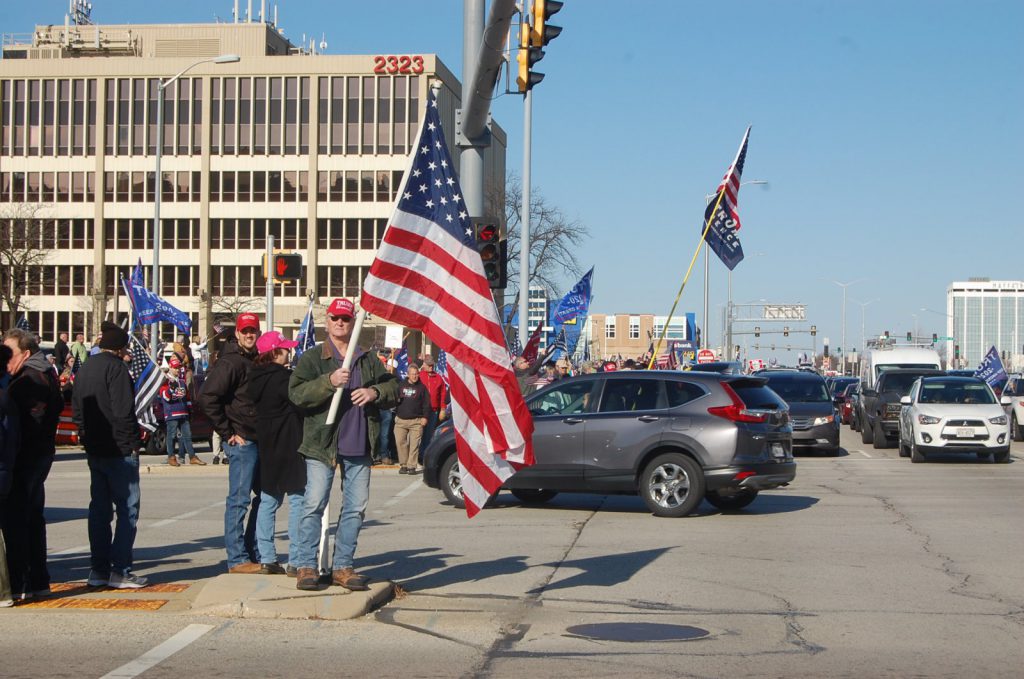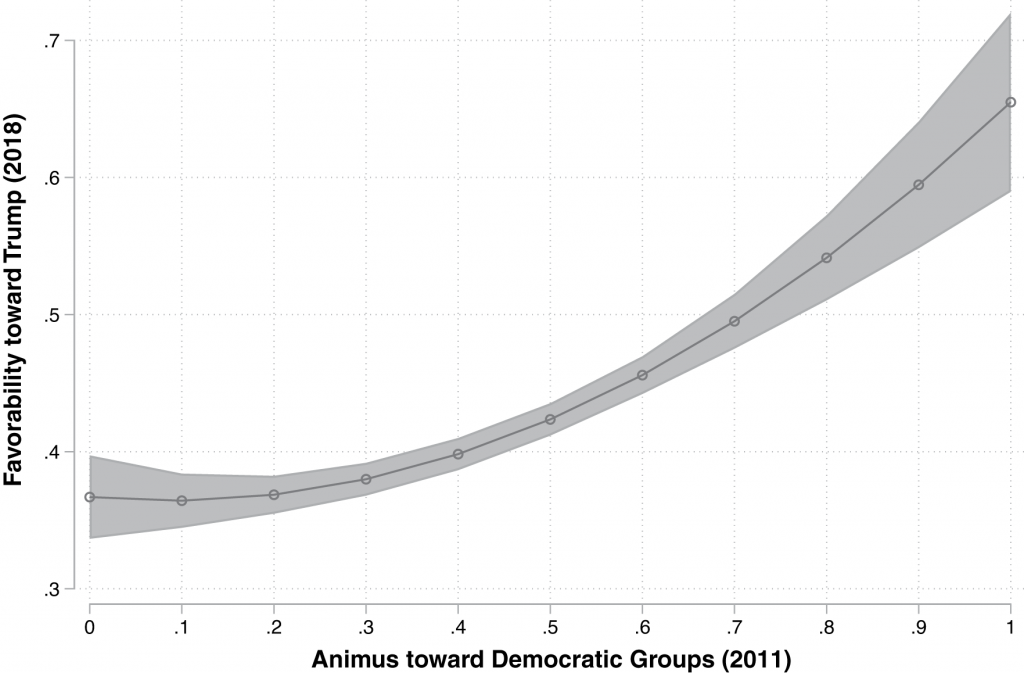How Trump Polarized Voters
Part of shift in Republican Party but no GOP politician has same impact as Trump.
How have Democrats and Republicans changed in Wisconsin and nationally?
There is actually a very specific way to measure this. Among political scientists, the most frequently used scale to measure ideology in the U.S. Congress is DW-nominate. The scale is based on rollcall voting in the U.S. House and Senate. The histogram below shows the ratings of the current (117th) Congress.
The scale runs from -1 to 1, with zero at dead center. Rollcall votes for the liberal position are given negative numbers, and therefore are shown on the left. Conservative voting is given a positive number and therefore shown on the right.
Note that currently there is no one in the center and no overlap between the two parties. The most liberal Republican is more conservative than the most conservative Democrat as measured by DW-nominate.
This contrasts with the 92nd Congress that met between 1971 and 1972. Fifty years ago, there were a number of Republican U.S. Senators and House Representatives whose voting records were more liberal than some Democrats, and vice versa.
The next graph contrasts the Wisconsin congressional delegation today with that of 50 years ago, using the DW-Nominate data and with blue and red dots to represent each Democratic or Republican member of the delegation. The dots spread across the top are from 1971-’72, when Wisconsin had ten House representatives, half from each party, and two Democratic senators (Gaylord Nelson and Willam Proxmire). The dots at the bottom are from today, with the House delegation reduced by two, because other states have added more residents.
The horizonal scale shows how the members are rated using DW-nominate, with dead center at zero. The main change from the top group of 50 years ago to the bottom group of today is the move of the red (Republican) dots further to the right while blue (Democratic) dots are in about the same ideological territory as in the 1970s. The state’s Republican delegation has become much more conservative than it was 50 years ago.
One cause often cited for the diminished overlap between the parties is the shift of conservative Democrats to conservative Republicans with the ending of legal segregation in the South. However, that does not explain the similar evolution in Wisconsin and several other northern states.
Looking at the senators in the 92nd Congress, I was struck by the number of liberal Democrats who represented states outside the South which today offer barren ground for Democrats. Examples include Frank Church in Idaho, George McGovern in South Dakota, and Frank Moss in Utah. Often, these liberals were paired with a very conservative Republican.
Gerrymandering is another factor. A successful gerrymander tends to avoid swing districts and create as many safe seats for the dominant party as possible. The result is one-party districts that are safe from a challenge from the other party, but not from a candidate that can appeal to the base — pushing the party further from the middle — in the primary.
A recent analysis looked at the views of Americans who believe the 2020 election was stolen. The analysis used responses to surveys by the Democracy Fund’s Voter Study Group in partnership with the Cooperative Campaign Analysis Project (CCAP) and YouGov. Most recently, about 5,900 people were surveyed before and after last year’s election.
It found that support for Donald Trump and for “stop the steal” was closely related to:
- Antipathy toward Democrats
- Antipathy toward immigrants
- A belief that racism is not a problem
- Support for traditional family values and gender roles
- Nationalism
- Conservative economic attitudes
Surprisingly considering Trump’s preference for strongmen in other countries, from Vladimir Putin in Russia to Kim Jong-un in North Korea, support for a ‘strong leader’ was only weakly related to support for Trump and for “stop the steal.” The other beliefs, particularly the antipathy toward immigrants is closely matched to Trump’s own rhetoric. That brings up the question: do Trump supporters’ beliefs stem from their support for Trump? Or do they support Trump because he gives voice to their pre-existing beliefs?
This analysis looked at responses to questions aimed at assessing hostility to four “Democratic-linked groups” — Blacks, Hispanics, Muslims, and gays — on the 2011-12 survey. It found a strong correlation between hostility towards those groups and Trump approval and favorability in the 2017 and 2018. The next graph, taken from the article, summarizes the relationship between animus toward the four Democratic groups expressed in answers to the 2011 survey (on the horizontal axis) and Trump favorability based on the 2018 survey (on the vertical axis). The greater a voter’s animus toward these four groups the more likely he or she supports Trump.
By contrast, the analysis found virtually no relationship between hostility towards those groups and approval of Paul Ryan, Mitch McConnell, or the GOP itself.
Thus, it appears that, rather than fitting their views to those of Trump, the strongest Trump supporters found in Trump someone willing to express their views outright, in a way that Ryan or McConnell did not.
Although politics, unlike economics, is an inherently qualitative business, quantitative models like DW-nominate and the Democracy Fund’s voter surveys can help understand and test what is going on. In this case they provide dramatic evidence for the rapid embrace of the Trump world view.
Data Wonk
-
The Imperial Legislature Is Shot Down
 Jul 10th, 2024 by Bruce Thompson
Jul 10th, 2024 by Bruce Thompson
-
Counting the Lies By Trump
 Jul 3rd, 2024 by Bruce Thompson
Jul 3rd, 2024 by Bruce Thompson
-
How Did Politics Affect Covid Deaths?
 Jun 26th, 2024 by Bruce Thompson
Jun 26th, 2024 by Bruce Thompson


























Just proves that right wingers are easily manipulated tools.
In a very informative piece, Bruce Thompson notes the transformation of Southern racists (my term, not his) from being Democrats (Dixiecrats) to being Republicans with the passage of Civil Rights and Voting Rights Acts in the mid-1960s. He then states that this development “does not explain the similar evolution in Wisconsin and several other northern states.”
Actually, I believe it does explain it, especially when considered along with the soon-to follow disastrous deindustrialization and northern patterns of rigid physical segregation. George Wallace did not achieve his shocking numbers in the 1964 Wisconsin Democratic presidential primary because of his fiscal or good government policies. It was pure racism and white victimization. Republicans immediately saw the opening; and aided by a shrinking “working class” (across races) and declining living standards, the Southern Strategy moved north. Aided by urban violence and the revolutionary fantasies of the Black Power movement.
The line from Wallace to Reagan and ultimately Trump, and today’s Republicans as the White People’s National Party, is a pretty straight one. And, as Bruce Thompson points out, it won’t go away even when Trump does. There are a number of wanabees (Cotton, Hawley, Cruz, and others) out there, and zero-sum, scapegoat driven cruelty is now baked into the system, and defines the Republican Party. As the Republican response to the January 6 coup attempt demonstrates, the guardrails are gone. It is no longer clear what, if anything, Republicans are not capable of going forward.
If there are “lessons of history,” one may be that they don’t ring a bell when you are at a point of no return. Think August, 1914, 1859, and, maybe, November, 2016. When the unthinkable becomes thinkable, you are on the way to it being inevitable. In this sense, it might be worth thinking about how we avoid civil violence, while holding on to some form of democracy, especially linked to next years elections. It’s also worth remembering that, as a noted historian said, “we should always beware that that what now lies in the past once lay in the future.” Think 1859, looking back from 1865.
I saw a bumper sticker yesterday that said, “Make racists afraid again”. Funny. Not funny. There was a time when those who held racist views and beliefs just didn’t say real much. Now, however, they have a platform for their awful beliefs: the republican party.